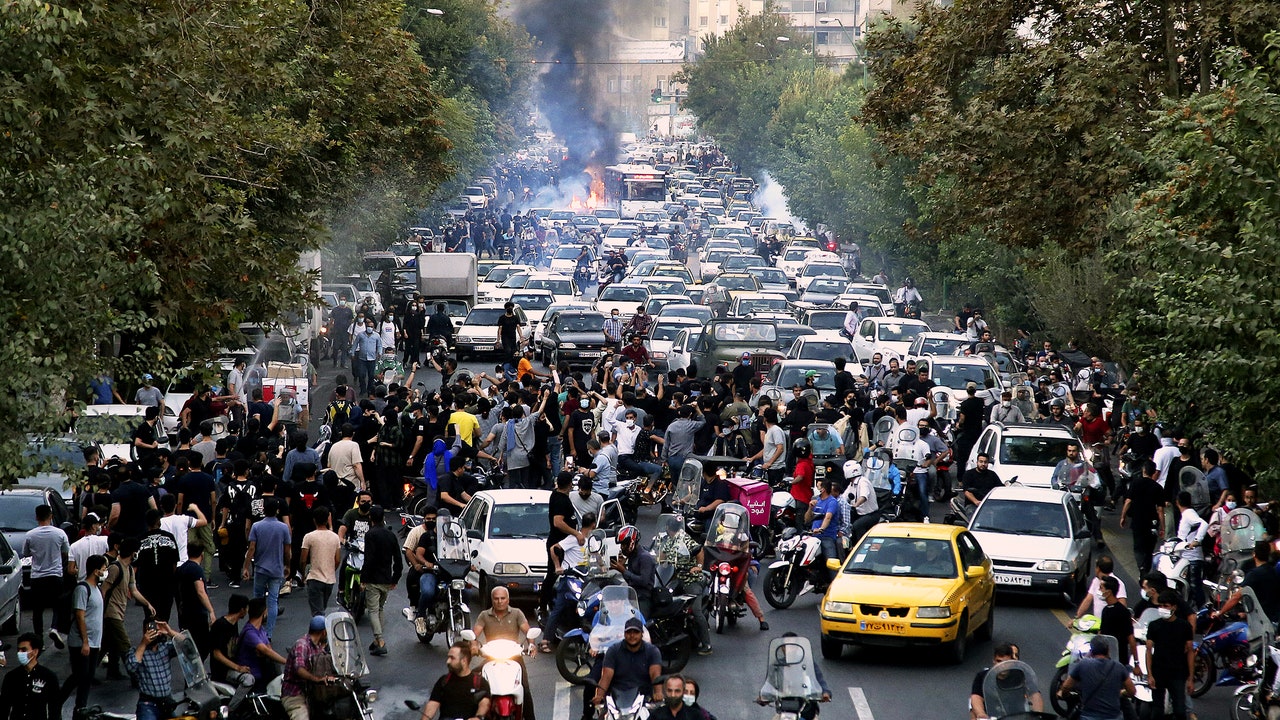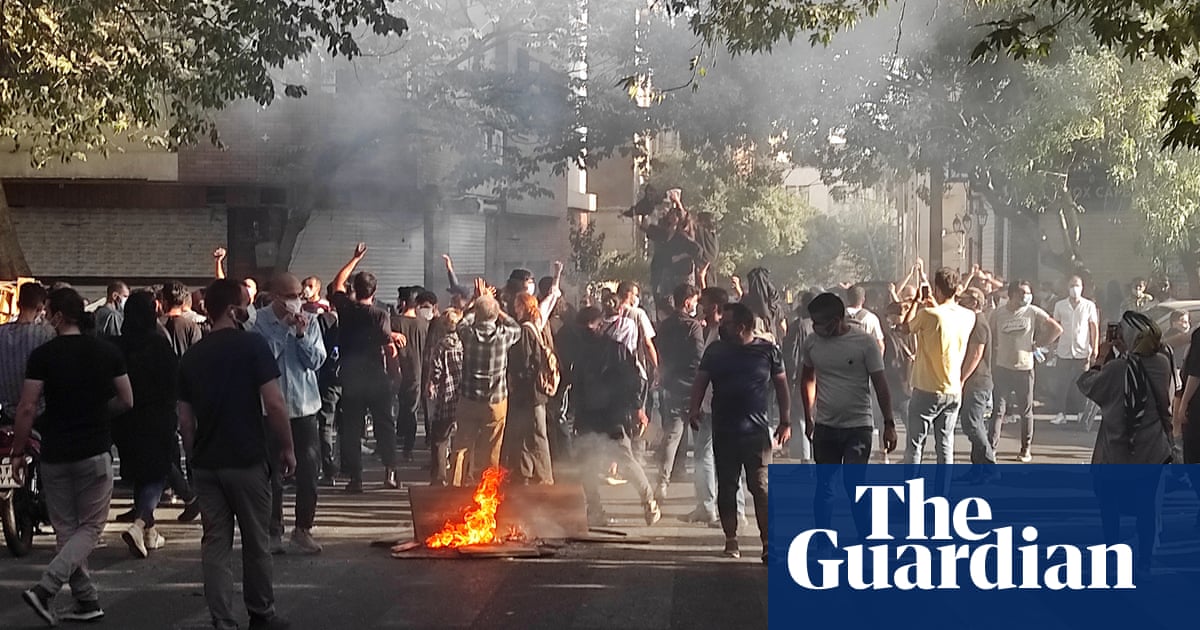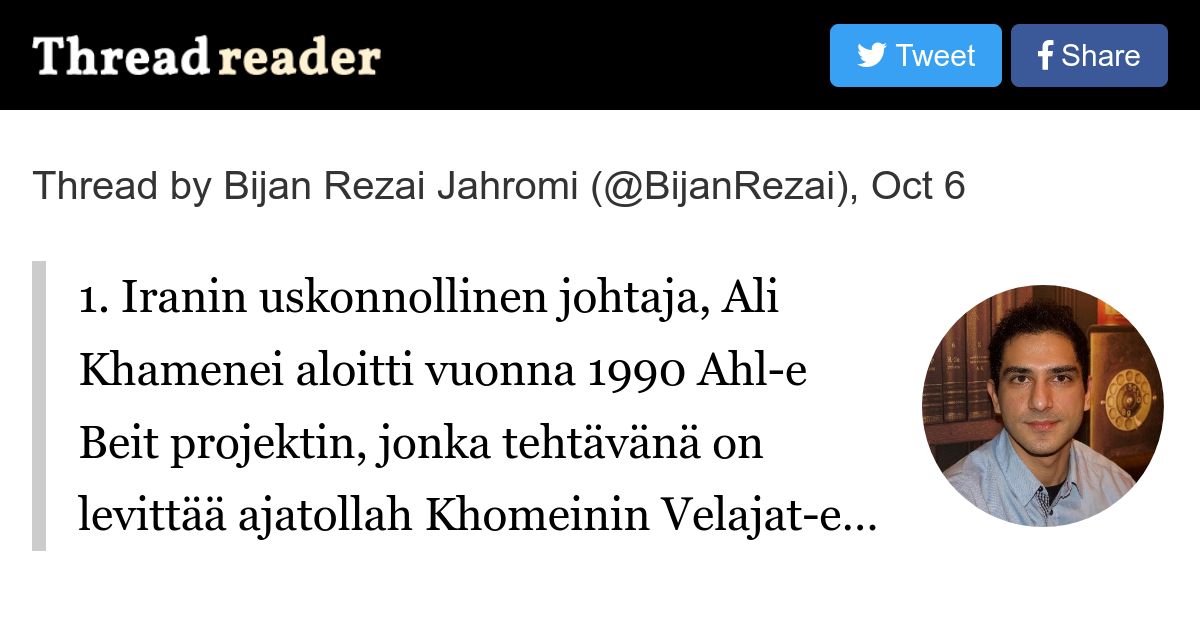Install the app
How to install the app on iOS
Follow along with the video below to see how to install our site as a web app on your home screen.
Note: This feature may not be available in some browsers.
You are using an out of date browser. It may not display this or other websites correctly.
You should upgrade or use an alternative browser.
You should upgrade or use an alternative browser.
Iranin protestit
- Viestiketjun aloittaja Puurokulho
- Aloitus PVM
Iranin naisilla on enemmän munaa kuin Venäjän miehillä!
Jotenkin outoja nuo videot venäjältä. Ei siellä uskalla kuin yksi tai kaksi pistää vastaan ja muut vain katselee.Iranin naisilla on enemmän munaa kuin Venäjän miehillä!
Norppa
Eversti
Teheraniahan on Beirutin tavoin kutsuttu Lähi-idän Pariisiksi. Pahlavin aikaan yksi kansainvälisiä kohokohtia oli Teheranin muotiviikot…Iranin armeijan miehilläkin on vaimot, tyttöystävät, äidit, mummot ja siskot. Jos he ajattelevat, että nuo naiset ovat tärkeämpiä kuin pappien sorto niin tuo vallankumous menee päätyyn asti. Muistetaan, että vielä noin 50 vuotta sitten Iran/Persia oli aika lailla vapaamielinen maa verrattuna tähän aikaan. Se ei ole samanlainen 1000 vuotta maakuopassa asunut kansa kuin tuo itänaapurimme.
50 vuotta sitten maa oli vapaamielisempi kuin moni Euroopan maa. Pitää muistaa, että 60-luvun Suomessakaan ei yksinäisellä naisella ollut asiaa ravintolaan.
Sanavalmis Muurinen
Kenraali
Polttopullot saatu käyttöön ja poliiseja kääntynyt mielenosoittajien puolelle.

Huomatkaa, että väkijoukko hyökkää pamputtajia vastaan eikä loottaa paikallisia kauppoja. Näin mellakoidaan oikein.
Sanavalmis Muurinen
Kenraali
Helsingin Kampissa mielenosoitus, joka eskaloitui samalla myös Putinin vastaiseksi.
AMC
Ylipäällikkö
Tää alkaa menee mielenkiintoiseksi.
” Teheranin Iranin poliisipäällikkö kertoo alaisilleen, että heidän täytyy tukahduttaa kansan mielenosoitukset hinnalla millä hyvänsä, jopa tappaa mielenosoittajat, he sanovat, että tätä Qasem Soleimani haluaisi.”
Teheranin Iranin poliisipäällikkö kertoo alaisilleen, että heidän täytyy tukahduttaa kansan mielenosoitukset hinnalla millä hyvänsä, jopa tappaa mielenosoittajat, he sanovat, että tätä Qasem Soleimani haluaisi.”
 Teheranin Iranin poliisipäällikkö kertoo alaisilleen, että heidän täytyy tukahduttaa kansan mielenosoitukset hinnalla millä hyvänsä, jopa tappaa mielenosoittajat, he sanovat, että tätä Qasem Soleimani haluaisi.”
Teheranin Iranin poliisipäällikkö kertoo alaisilleen, että heidän täytyy tukahduttaa kansan mielenosoitukset hinnalla millä hyvänsä, jopa tappaa mielenosoittajat, he sanovat, että tätä Qasem Soleimani haluaisi.”No siihen ei paljoa vaadita.Iranin naisilla on enemmän munaa kuin Venäjän miehillä!
ido59
Majuri
Lyhyessä videossa hieman taustoja. Mm 78 vallankumouksen jälkeinen hallinnon kyvyttömyys uudistua (tietysti, koska islam). Maata johtaa geriatrinen ääri-islam -porukka, joilla toinen jalka haudassa. Kapinoijilla on elämä edessä. USA:n pitää tasapainoilla, koska ei halua Iranista tulevan P-korea, vaan E-korea.
vompatti
Kenraali
Poliiseja liittynyt mielenosoittajiin, meneekö vielä normaalin toiminnan kategoriaan vai jotain suurempaa?
In the Iranian city of Shahrud, surrounded by hundreds of protesters, two women climb onto a platform and defiantly wave their hijabs above their heads in an act of public defiance. The scene, caught on video, is posted online by the 1500tasvir Instagram account. In recent days, the account has published dozens of videos from Iranian towns and cities as thousands of people protest the death of 22-year-old Mahsa Amini, who died in police custody after being arrested by Iran’s “morality police.”
In another video shared by 1500tasvir, women burn their headscarves while chanting for freedom. Protesters are shown confronting police officers in another. And other videos claim to show people bleeding, injured, or dead, following brutal clashes with police officers as protests have spread to more than 80 cities across Iran. “They stood against the police, who are armed, and they [protesters] just shout at them,” says one person behind the 1500tasvir Instagram account, whom WIRED is not naming to protect their safety.
The 1500tasvir account was set up in 2019 following widespread protests in which hundreds of people were killed by police. During those protests, Iranian officials totally shut down the internet, stopping people from organizing protests and limiting the information flowing in and out of Iran. Now history is repeating itself. But this time, more people are watching.
As thousands of people have taken to the streets to protest the death of Amini this week, Iranian officials have repeatedly shut down mobile internet connections and disrupted the services of Instagram and WhatsApp, two of the most popular social media services in the country. The internet shutdowns are the largest since November 2019 and raise fears about further atrocities. So far, more than 30 people have reportedly been killed, while the Iranian government has admitted to 17 deaths.
“Shutting down mobile internet service has become a go-to for the Iranian government when dealing with civil unrest,” says Doug Madory, director of internet analysis at monitoring firm Kentik, who has been following the shutdowns. “People were using these services to share videos of the protests and the government’s crackdown, so they became targets of government censorship.”

Iran's Internet Shutdown Hides a Deadly Crackdown
Amid protests against the killing of Mahsa Amini, authorities have cut off mobile internet, WhatsApp, and Instagram. The death toll continues to rise.
Nyt on Iranin naiset tehneet oman version Bella Ciauosta
Iran lämpenee edelleen. Tämä jostain perjantai moskeijan jälkeisesta protestista, jossa nyt 41 tapettua jo. Pankaa twitteriin Zehedan, nin tulee palavia autoja ja hillumista.
Tää sopii tänneAlkaa Venäjän ainoilla liittolaisilla olla vähän isompia ongelmia...
Vähemmälle äseurannalle jäänyt viime päivinä tämä #IranRevolution2022, mutta ilmeisesti pidätysten kuvaaminen saa liipasinsormen kiristymään:
Rambo
Majuri
Iranin hallinto jatkaa sunnien joukkomurhaa Golestanin maakunnassa, lapsia on ammuttu.
Iranian security forces have clashed with students at a prominent university in Tehran, social and state media reported, in the latest sign of a deadly clampdown on nationwide protests that were ignited by the death in custody of a young woman.
The anti-government protests, which began at 22-year-old Mahsa Amini’s funeral on 17 September in the Kurdish town of Saqez, have spiralled into the biggest show of opposition to Iran’s authorities in years, with many calling for the end of more than four decades of Islamic clerical rule.
Activist Twitter account 1500tasvir, which has about 160,000 followers, posted several videos showing Sharif University, traditionally a hotbed of dissent, surrounded by dozens of riot police on Sunday.

Iran protests: riot police clash with students at Sharif university
Unverified social media videos show security forces firing teargas amid reports some students are trapped in campus car park
Students had been protesting at numerous universities on Sunday and demonstrations were held in several cities such as Tehran, Yazd, Kermanshah, Sanandaj, Shiraz and Mashhad, with participants chanting “independence, freedom, death to Khamenei,” earlier social media posts showed.
The protests have not abated despite a growing death toll and the crackdown by security forces using teargas, clubs, and in some cases, according to videos on social media and rights groups, live ammunition.
Iran Human Rights, a Norway-based group, in a statement said that “so far 133 people had been killed across Iran“, including more than 40 people it said died in clashes last week in Zahedan, capital of the south-eastern Sistan-Baluchistan province.
Bijan Rezai Jahromin twiittiketju Iranin toiminnasta Euroopassa ja Suomessa.

 threadreaderapp.com
threadreaderapp.com

Thread by @BijanRezai on Thread Reader App
@BijanRezai: 1. Iranin uskonnollinen johtaja, Ali Khamenei aloitti vuonna 1990 Ahl-e Beit projektin, jonka tehtävänä on levittää ajatollah Khomeinin Velajat-e vaqeeh valtioteoriaa Iranin rajojen ulkopuolelle. Tästä ...…
